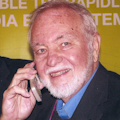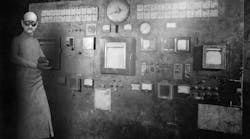Vacuum tubes disappeared from electronic products years ago. Yet there have been some lingering vacuum tube-based products in production. The last major vacuum tube retirement was the long-lasting cathode ray tube (CRT). In the late 1990s and early 2000s, the CRT finally gave way to the LCD/LED and other flat panel displays in video monitors and TV sets. Now another major vacuum tube product seems poised to fade away: the microwave oven.
The main component in a microwave oven is a magnetron, a high power microwave vacuum tube oscillator. It operates at 2.45 GHz. It radiates the food heating and cooking it. The magnetron was invented during World War II for radar. Magnetrons can easily generate thousands of watts of power. Electrons from a filament-heated cathode are attracted by a high voltage anode but a surrounding magnet modifies the electron paths thereby exciting cavity resonators tuned to the desired frequency producing a continuous wave (CW) signal. That signal is coupled to an antenna that directs the energy according to the application.
The magnetron was the component of choice for radar but also RF heating applications. Industrial uses came first but in the 1970s, several companies offered “radar ranges” for consumer cooking. They rapidly became popular because they reduced cooking time and made cooking more convenient. Today virtually every kitchen has a built in microwave as well as a conventional oven. If not, a counter top microwave oven is usually present. It is a must-have consumer appliance that we all take for granted today.
Despite the wide microwave acceptance, they do have their problems. They often cook unevenly and typically lose power over time as the magnetron filament and cathode deteriorate. At last it is possible to replace the magnetron with solid state devices.
Up until now there were few if any transistors that could crank out hundreds and certainly not thousands of watts or power at microwave frequencies. That has changed in the past years with advances in GaN technology and advanced silicon LDMOS. Today Freescale Semiconductor is offering devices that will let appliance makers produce even better microwave ovens.
The product of interest is Freescale’s new MHT1003N, a 250 watt LDMOS transistor for 2.45 GHz that provides a power-added efficiency (PAE) of 58%. Another device targeting RF heating applications is the MHT1002N for 915 MHz that can deliver 350 watts at 63% PAE. Using the MHT1003N, manufacturers can use from one to eight of these 250 W units to build a microwave oven with the desired power level. And the magnetron’s 4 kV power supply goes away in place of a supply of 28 to 50 volts. Furthermore, the crude on-off control of the magnetron can be replaced with full variable power control. Using multiple antennas, one per amplifier, provides better coverage of the cooking chamber. This allows food to be cooked more precisely while the unit operates more efficiently. And the product lifetime is significantly greater.
Freescale is also offering an RF Power Tool System, a development platform of hardware, software and documentation that gives inexperienced RF appliance developers all the tools to create a product fast and easy. For more details on all this, go to: www.freescale.com/RFheating.
Maybe the magnetron is really not the last vacuum tube product, but close to it. There are still some other microwave tubes around like the klystrons in some satellite ground stations and the traveling wave tubes (TWTs) in satellites. The new GaN transistors will probably replace some TWTs in future satellites but klystrons will be tough to replace.
It will be a while before all the magnetron microwave ovens disappear just as it is taking years for CRT monitors and TV sets to fade away. But you can look forward to the future where your popcorn will be more precisely popped in a solid state oven.
About the Author

Lou Frenzel Blog
Communications Technology
Click here to find more of Lou's articles on Electronic Design.




